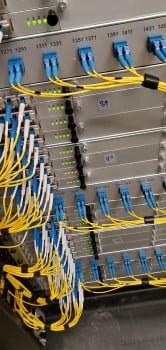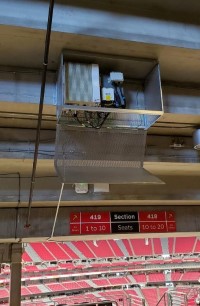Seamless connections, convenience, personalization and immersive experiences are key elements in the fan experience. This includes digital ticketing, personalized promotions, high-definition broadcasts, selectable camera replays, augmented reality-based player information, and even time-sensitive betting, to name just a few. While each fans experience and expectations will be unique to them, there is a common factor, they require unique digital content that can be delivered to their smartphones — and fast.
Until now, Mobile Network Operators (MNO) have been deploying 5G, specifically speed-centric mid-band frequencies, and driving new bandwidth outdoors. But now, as explained here, they are driving these mid-band frequencies in stadiums and arenas, creating faster experiences across the entire MNO network – both outside and inside.
What does a 5G stadium look like?
According to Stadium Tech Report, last year’s Super Bowl generated more than 35% more traffic than the previous Super Bowl, and expectations are similar for this year.

Today’s champion-level stadium requires new technology and more bandwidth to satisfy both the in-stadium experience and the shared-stadium experience. A 5G technology known as 5G New Radio (NR) Time Division Duplex (TDD) is key to supporting this continued and growing demand. 5G NR TDD allows for more efficient spectrum utilization and supports 5x channel bandwidths, driving greater throughput to more users than 4G LTE. As a result, new wireless records are being set:
- Largest 5G NR TDD deployment supporting all nationwide MNOs
- Largest spectrum utilized in a single venue – over 900 MHz
- Largest deployment of full C-band and mid-band frequencies
- Most dense 5G deployment with more than 100 zones
- Fastest user connections, commonly from 400 Mbps to 700 Mbps, but even over 1 Gbps
All this is done while ensuring backward compatibility for 4G LTE FDD and synching with the outdoor network, requirements that are necessary for a comprehensive experience.
How is a 5G stadium built?
Just like a well-crafted game plan, building a stadium network that can deliver the ultimate fan experience takes time and preparation. A champion-level stadium requires approximately two years of planning and execution, including design, deployment,
optimization, commissioning, and integrating of the stadium’s Distributed Antenna System (DAS) with multiple MNO networks and deploying, on average, almost 2000 antennas.
Advanced fiber technologies connect the stadium to the MNO network – often at a point that is several miles away from the stadium. And digital RF interfaces drive efficiency and contribute to green initiatives as they minimize RF equipment in the stadium, leading to huge savings in square footage, electricity, and HVAC – saving from 500-750 metric tonnes of CO2.
It’s not just the stadium though, venues around the stadium, including the airport, hotels, and other venues are also connected, so that fan experience starts as soon as they arrive and is present wherever they go.
It’s a win for the venue.
Regardless of the sport, or location, fan engagement is central to the success of stadiums across the globe. Delivering a great in-stadium experience, where no one is taken out of the action, builds fan loyalty and benefits not only venue owners, but sponsors alike.
It’s a win for the fans!
Beyond seeing a favorite team win, 5G and the speed it will bring for the fan experience will be amazing. CommScope is the leader in DAS for stadiums and arenas, and we are proud to help bring these new 5G experiences to champion-level venues all over the world. After all, we want to make sure that no one gets sidelined and misses capturing and celebrating that winning drive at the big game.











